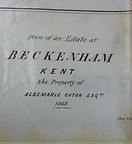

STORIES OF ST PAUL'S
Enter This Holy Place

St. Paul’s was part of a wave of church building which took place all over the country in the middle decades of the 19th century. In Beckenham, which with the arrival of the railways in the 1850s rapidly expanded from a rural village into a commuter suburb, no fewer than eight new churches were built between the 1860s and 1880s. A large part of Beckenham and Penge belonged to the estates of the wealthy Cator family, who had lived until shortly before this period in the grand 18th-century mansion in what is now Beckenham Place Park. In the 1860s the Cators were keen to develop what came to be known as New Beckenham as a desirable middle-class residential area, “with large houses, extensive gardens, wide tree-planted roads” and they saw building a church for the new neighbourhood as an essential part of the plan.



See the growth in housing between the two maps and the original location of the rail station.
The (unmarked) foundation stone of the present church was laid in October 1863. At first the building consisted of a single nave for the congregation and the chancel where the altar and lectern were placed. It was built in the imitation ‘Early Gothic’ style popular at the time, with pointed arches and other medieval-like features.. The intention of the Cator family always seems to have been to build a larger structure but for several years the chapel-like building, sometimes likened to a barn or even a dog kennel, remained as it was.



During the 1860s the neighbourhood continued to grow as more and more houses were built; as a result the potential congregation for a larger church with its own parish was expanding, so in 1868 proper plans to enlarge and embellish the existing structure were drawn up. The chancel on the east was extended, aisles on either side, north and south, were added, an entrance with a spacious tiled porch was created on the south side, a tower with a spire (and a few years later, a clock which chimed the hours) was erected, and finally a large garden surrounding the building was planted.
More Info Below:

The church, finally looking much as it does today, with its tall slender spire visible for miles around, was consecrated with a special service held on 17 May 1872. The first vicar, Rev. W.G. Wrightson, was appointed (through Cator patronage - the Cator family continued to have a say in the selection of vicars up to the 1950s) and formally inducted at the beginning of June, and the boundaries of the new parish (‘New Beckenham’, to distinguish it from the old parish of ‘Beckenham’, from which it had been carved out) were officially recorded, again in June 1872.



